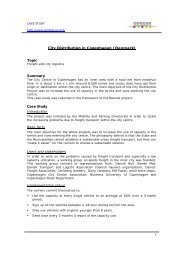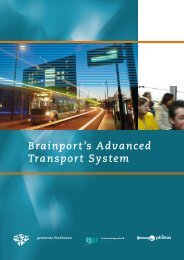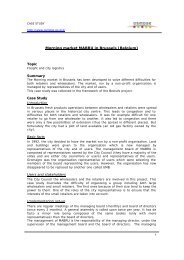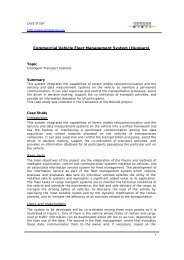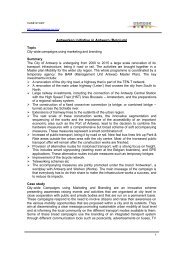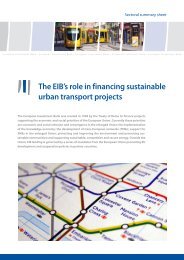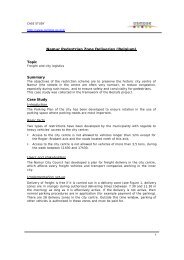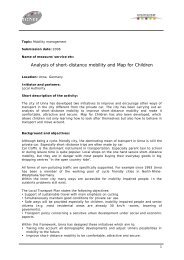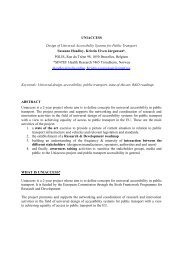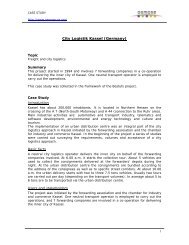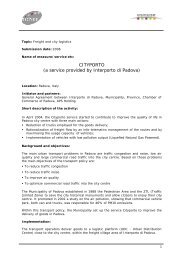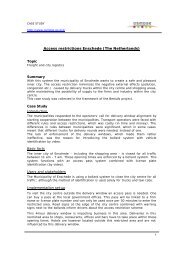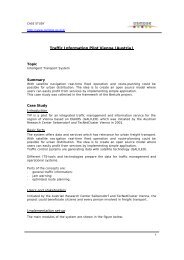Successful transport decision-making - Osmose
Successful transport decision-making - Osmose
Successful transport decision-making - Osmose
Create successful ePaper yourself
Turn your PDF publications into a flip-book with our unique Google optimized e-Paper software.
Vol 2 - Table of Contents <br />
Next<br />
Designing and carrying out a questionnaire survey<br />
The key to preparing a successful questionnaire survey is ensuring the respondents understand what the questionnaire is for and<br />
what is required of them. All questions should be clear, concise and easy to understand. The diagram below illustrates how a<br />
questionnaire survey should be designed and administered:<br />
<br />
<br />
<br />
1. Confirm objectives/outcomes<br />
It is always recommended to identify the objectives of the<br />
questionnaire/survey and how the results will be used.<br />
2. Develop questionnaire<br />
It is important to prepare a questionnaire that people will<br />
be able to understand and respond to. All questions<br />
should be appropriate and relevant.<br />
3. Determine sample size<br />
It is important to identify an appropriate statistical sample.<br />
Consideration should be given to the number of people<br />
consulted and the number of people affected.<br />
4. Prepare the sample<br />
It is recommended to combine all the distribution lists/<br />
databases / telephone numbers that will be used in the<br />
distribution of the questionnaire.<br />
5. Distribute the questionnaire<br />
Administer the questionnaire using the most appropriate<br />
technique or combination of techniques.<br />
6. Coding/editing of feedback<br />
It might be necessary to code responses i.e. sort them<br />
systematically, in order to analyse them statistically.<br />
7. Data analysis<br />
At this stage all responses are brought together and analysed.<br />
This might involve statistical analysis from ‘closed surveys’ or<br />
examining more detailed information from ‘open surveys’.<br />
8. Report preparation<br />
The results of the questionnaire should be summarised in a<br />
report. This can be shown to stakeholders and will ensure<br />
survey findings can be used easily in the future.<br />
9. Findings feedback<br />
It is recommended to present the findings of the<br />
questionnaire/ survey back to the project team to ensure that<br />
they are familiar with the results of the process.<br />
10. Feedback to participants<br />
It is recommended that the findings and results are fed back to<br />
the participants to encourage a transparent engagement<br />
process. These could be presented in a newsletter or in a<br />
public meeting.<br />
TIPS for undertaking your questionnaire<br />
Carry out a test of the questionnaire to highlight any problems with its structure or wording.<br />
Ensure the questionnaire is not too long - this will discourage people from filling it in or they will only partly complete it.<br />
It might be necessary to provide an incentive to encourage respondents to return the questionnaire e.g. a pre-paid envelope.<br />
Practical information<br />
Who participates and how?<br />
Questionnaires are a useful way of obtaining information<br />
from individuals and groups. These might be<br />
administered to a specific group of people or a<br />
representative sample of the population. Using<br />
questionnaires might help to get people involved who<br />
might not ordinarily participate in a project.<br />
How much does it cost?<br />
The cost of designing and carrying out a questionnaire<br />
will depend on the sample size and how it is administered.<br />
Sending out surveys through the mail for example, is<br />
more costly than posting a survey on a website, but might<br />
be more effective in terms of the number of responses<br />
returned. Using a questionnaire can be cheaper and less<br />
time consuming than other techniques, such as<br />
interviews.<br />
What skills are required?<br />
Questionnaires should be designed and carried out by<br />
experienced staff. Those administering street and<br />
telephone surveys should have an understanding of how<br />
to deal with the public. For large, structured surveys<br />
external assistance may be required for statistical<br />
analysis of the results.<br />
How is it used with other techniques?<br />
Questionnaires can be very useful in supporting other<br />
techniques. Survey results for example, can provide<br />
useful data and support for focus groups or workshops<br />
and questionnaires can be used to identify individuals<br />
who would like to get involved in more engagement<br />
activities.<br />
What are the drawbacks?<br />
Some questionnaires receive poor response rates and<br />
incentives may be required to encourage people to return<br />
their questionnaires. Used in isolation, ‘closed’<br />
questionnaires do not produce in depth information and<br />
may not fully identify key issues or problems.<br />
Questionnaires will not be appropriate for some<br />
stakeholders e.g. those with low literacy levels.<br />
<br />
T15<br />
103



